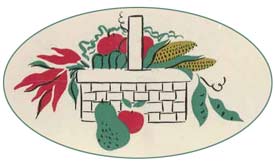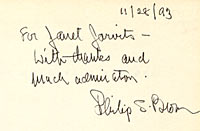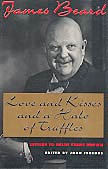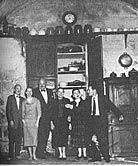 |
go to:
CHARITABLE COOK BOOKS General Inventory Shopping Cart Home |
FAQ
 |
go to:
CHARITABLE COOK BOOKS General Inventory Shopping Cart Home |
Charitable Cook Books from the Collection of Helen Evans Brown
Is this Helen's entire collection of charitable cook books?
Where are the California imprints?
The books seem pricey. Why?
Do all the books have a bookplate in them?
What do "Br" and "Ck" mean in the description of the books?
Did Helen use her charitable cook books?
Helen Brown's Book Collection
How many books did Helen own?
What kind of books were in the collection?
What are the details of Janet Jarvits' purchase of Helen's book collection?
Why is this collection not being sold as a whole?
Is the Charity Cook Book Catalog the first catalog Janet Jarvits put out offering Helen's collection for sale?
How was the collection important in the growth of Cook Books by Janet Jarvits, Bookseller?
Bibliography
What books did Helen Evans Brown write?
What was ground-breaking about the West Coast Cook Book?
What was the nature of Helen's relationship with James Beard?
More About Helen and Philip S. Brown
Who were Helen and Philip S. Brown?
What was Helen's importance in the food business?
How was Philip involved in Helen's life?
Did Philip have a place in the food world after Helen?
What is a charitable cook book?
A charitable cook book is a cook book published to raise money for some cause or another. The first fund-raising cook books were written in the United States during the Civil War, and sold at the Sanitary Fairs held to raise money for the military casualties and their families.
Other societies, mostly formed by women, continued to publish receipt books to raise money for various causes after the war. Mostly these books were published locally.
These books record how cooking actually was at the time of their publication for the vast majority of people, as opposed to books authored by famous chefs or cooking school marms. These books tell a communal women's history of a particular area, forming an important part of the written history of women.
Who was Helen Evans Brown?
Helen Evans Brown was regarded as "the culinary authority of the West Coast," during the 1950s and 1960s.
James Beard regarded her on a level with M.F.K. Fisher. When Craig Claiborne was chosen to succeed Jane Nickerson as food editor of the New York Times, Beard objected along with Nickerson. The two both felt that Brown should have been chosen for the position (how could anyone have known then how well Craig Claiborne would do?).
Brown's West Coast Cook Book got good reviews, much notice and has been said to have influenced eating habits everywhere.
+ More about the life of Helen Evans Brown and a bibliography of books written by her.
What are some highlights of the collection?
Some highlights of the collection include:
Carolina Rice Cookbook -- an early text on Rice, immortalized in the history book by Karen Hess, The Carolina Rice Kitchen
Goodies For The Good -- a rare imprint from Indian Territory
Note: A good number of the items in this catalog were reported as the only copies known, according to Margaret Cook's America's Charitable Cooks.
Charitable Cook Books from the Collection of Helen Evans Brown
| Is this Helen's entire collection of charitable cook books? | |
| No, this catalog contains the most rare of her charitables as well as other hard-to-find ones in nice condition. This catalog does not contain any of the California imprints. |
| Where are the California imprints? | |
| The Huntington Library of San Marino, California purchased Helen's California imprints from Philip S. Brown, Helen's husband. |
| The books seem pricey. Why? | |
| Most of the books in the charitable cook book catalog are hard-to-find and some even rare. Some of the rare items are the only copies known (refer to Margaret Cook's America's Charitable Cooks). In the year 2000, this kind of material is very difficult to obtain. Being able to purchase it, instead of just view it in a rare book library or museum is noteworthy. |
| Do all of the books have a bookplate in them? | |
| No. When a bookplate is present it is stated in the description of the book.
As mentioned above, Philip S. Brown was Helen's husband. You may see his name listed in some of the book descriptions when books are inscribed to both he and Helen or when books have a bookplate which has both of their names on it. |
| What do "Br" and "Ck" mean in the description of a book? | |
| These are both bibliographic citations. "Br" refers to Bob Brown's Culinary Americana. The number following "Br" refers to the item number in that bibliography. "Ck" refers to Margaret Cook's America's Charitable Cooks. The number that follows "Ck" refers to the page an item is found on in that bibliography. |
| Did Helen use her charitable cook books? | |
| Yes. The books which have a pencil checkmark on the front fly were used in West Coast Cook Book. Notes with recipes and page numbers were found tucked in many of the books. Philip S. Brown, Helen's husband, explained that Helen spent hours and hours poring over her cook books and that the charitables had a special place in her heart. |
Helen Brown's Book Collection
| How many books did Helen own? | |
| Approximately 5000 items (not including the California imprints). |
| What kind of books were in the collection? | |
| Anything concerning food and its history. The largest component of the collection was the charitable cook books. Besides the charitable cook books, there were notable titles on just about every subject (For example, Joseph Vehling's Apicius, Emerson's Beverages, Verrill's Foods America Gave The World and etc.). |
| What are the details of Janet Jarvits' purchase of Helen's book collection? |
 |
In November of 1993 a colleague in the book world referred Janet to Philip S. Brown. Janet visited Philip in the Arroyo Seco home where he had lived with Helen and where the books still were. Janet obtained the collection, signing an agreement to pay for them over a period of twelve months. |
| Why is this collection not being sold as a whole? | |
| When Janet Jarvits purchased the collection it was in a state of disrepair.
Philip had abandoned the house, remarried and gone on to build a life without Helen (which he said was difficult, but necessary).
During the time the books sat in the house, a number of them were damaged by a fire, its smoke and the ensuing water used to put out the fire. Later, various critters also visited the library, snacking where they could. All of this rendered a portion of the library unusuable and even a danger to the other usuable books. Because of this; and the prior sale of the California imprints to the Huntington Library, the practical solution was to catalog the appropriate books and offer them for sale individually. |
| Is the Charity Cook Book Catalog the first catalog Janet Jarvits put out offering Helen's collection for sale? | |
| No, a catalog of the best of the non-charitable cook books was offered in 1994. |
| How was the collection important in the growth of Cook Books by Janet Jarvits, Bookseller? | |
| When Janet bought the collection, she had limited resources and only the beginnings of cook book knowledge. Buying the collection (and selling it) enabled Janet to learn about cook books in-depth through analyzing a collection built by an expert in West Coast food. With the knowledge and financial boost given by the purchase of the collection, she was able to open her store devoted exclusively to cook books in Burbank, California. The store is presently located in Pasadena, California. |
Bibliography
| What books did Helen Evans Brown write? | |
| Here is a list of the ones known at Cook Books by Janet Jarvits, Bookseller: |
| [No Date] |
CALIFORNIA COOKS: A COLLECTION OF THE ARTICLES ON COOKERY APPEARING IN THE FIRST TWENTY ISSUES OF THE CALIFORNIAN AND INCLUDING TWENTY ADDITIONAL NEW RECIPES |
| 1950 | CHAFING DISH BOOK |
| 1951 | PATIO COOK BOOK SOME OYSTER RECIPES (earlier edition?) SOME SHRIMP RECIPES (earlier edition?) |
| 1952 | HOLIDAY COOK BOOK WEST COAST COOK BOOK |
| 1953 | VIRGINIA CITY COOK BOOK (with Philip S. Brown) |
| 1955 | COMPLETE BOOK OF OUTDOOR COOKERY (with James Beard) |
| 1958 | BOOK OF APPETIZERS (with Philip S. Brown) COCKTAIL HOUR (with Philip S. Brown) |
| 1959 | BOYS' COOK BOOK (with Philip S. Brown) |
| 1961 | BREAKFASTS AND BRUNCHES FOR EVERY OCCASION (with Philip S. Brown) COOKOUT BOOK (with Philip S. Brown) |
| 1963 | BOOK OF CURRIES AND CHUTNEY (with William Veach) |
| 1964 | ADVENTURES IN FOOD (with staff of Sunset Magazine) |
| 1965 | A BON VIVANT'S COOK BOOK (with William Veach) |
| 1966 | SHRIMP AND OTHER SHELLFISH RECIPES (with Philip S. Brown) |
| + | And, articles from numerous magazines including- The Californian, Flair, House and Garden, Sunset, McCall's, Glamour, and Atlantic Monthly |
| What was ground-breaking about the West Coast Cook Book? |
 |
The West Coast Cook Book can be seen as a bridge between the earlier chatty non-scholarly voice in American cookery books (a la Joy Of Cooking) and the later more authoritative type of voice in books like James Beard's American Cookery; a voice that eventually evolved to scholarly and utterly serious in books like Reay Tannahill's Food In History and Karen Hess's Carolina Rice Kitchen. | |
 |
The West Coast Cook Book included historical detail, bibliographic reference and social commentary as tools in food writing (see below for examples). These inclusions upheld Helen's conviction that the West Coast had a "cuisine"- a cuisine worth partaking in. |
| Examples of approach in the West Coast Cook Book | |
| Detail of Experience: The recipe for "Lumber Camp Doughnuts" says -- "the camp cooks often pinched off bug hunks of the soft dough instead of rolling and cutting it, an idea which should be used more often." The details of experience suggested that Helen had tried the recipe both ways-- "pinching" and "rolling and cutting." | |
| Historical Detail: The historical side of the "Lumber Camp Doughnuts" recipe: "they used their own yeast in the old days" and for frying "bear lard was used in the early days." The recipe ends with the following note about a pre-1900 court case in San Francisco where "free lunch doughnuts" played a role: |
| Note: The reputation of San Francisco doughnuts, at least those served at the free lunches so popular in the saloons of '70s, '80s, and '90s was not so good. One story tells of that famous character, White Hat McCarthy (who always wore a white beaver hat as he drove about the city), who wanted to stop at his favorite saloon for a couple of quick ones, but found that he had lost his horse's headweight. A city ordinance made it illegal to leave a horse unhitched or untethered, so McCarthy weighted his reins with a doughnut from the free lunch counter. Haled into court, he was acquitted by the judge, who solemnly declared that everyone knew there was nothing heavier than a free lunch doughnut. |
| Bibliographic detail: Helen tells her source for "California Pioneer Apple Pie, 1852," as How We Cook In Los Angeles (1894) [one of the California imprints in her charitable cook book collection]. | |
| Socio-political commentary: Helen considers the difference between purple-skinned and white-skinned eggplants in the "Eggplant Notes." (Regarding the white-skinned variety) "It's used in the same way as its colored brother. They are identical under the skin." |
| What was the nature of Helen's relationship with James Beard? |

|
Helen and James Beard were close friends. They wrote each other at least twice a week until Helen's untimely death discussing culinary matters and gossip, and personal matters. Their letters have been published in a book called James Beard: Love and Kisses and a Halo of Truffles: Letters To Helen Evans Brown.
James Beard's dedication to American Cookery reads: "This book is dedicated to my favorite great ladies of the American kitchen: Eliza Leslie, Mrs. T.J. Crowen, Sarah Tyson Rorer, Fannie Merritt Farmer, Irma Rombauer, Helen Evans Brown, June Platt."
|
| Here's a picture of Helen and Philip with fellow foodies: |
 |
Order from left to right: Philip S. Brown, Bettina Mcnulty, Jim (Beard), Helen Brown, unidentified friend, and Henry Mcnulty |
More About Helen and Philip S. Brown
| Who were Helen and Philip S. Brown? | |
| Helen Evans Brown lived in Pasadena from 1937 until her untimely death in 1964. Before she met her husband, Philip, she had career as a successful caterer and was running a restaurant in New England. Philip courted her and persuaded her to head to the West Coast with him. There, Helen started work as a consultant to a Hollywood bakery and Philip began working in an antiquarian bookshop. Throughout the years both grew and developed in their chosen fields. |
| What was Helen's importance in the food business? | |
| After working as a consultant to a Hollywood bakery, Helen held various positions including: writing a monthly mailing piece for Balzer's, writing a monthly food column for the Californian, writing a monthly column for Western Family. Helen also wrote articles for such magazines as McCall's, Sunset, Flair, House and Garden and Glamour. |
| How was Philip involved in Helen's life? | |
| The two were married for almost thirty years during which time Philip built Helen's cook book collection, acted as taster, research assistant and typist on book projects. |
| Did Philip have a place in the food world after Helen? | |
| After Helen's untimely death, Philip provided entries for Margaret Cook's bibliography, America's Charitable Cooks, wrote articles for Balzer's, contributed a chapter on meat to The Great Cooks' Cookbook (1974), edited by James Beard. And etc. |